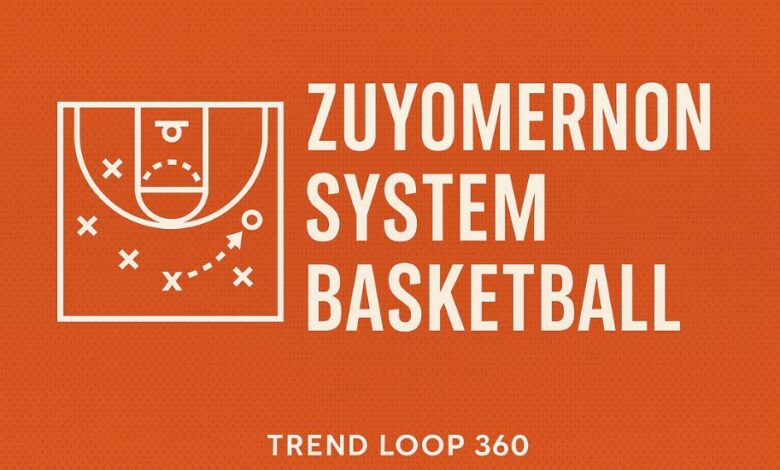Zuyomernon System Basketball: The Next-Gen Strategy Revolutionizing the Court

Basketball has evolved tremendously in the 21st century, with rapid advancements in analytics, player development, and tactical versatility. Among these evolutions, the Zuyomernon System Basketball has emerged as a powerful, modern framework that reshapes traditional gameplay. This system redefines player roles, emphasizes real-time decision-making, and blends intelligent movement with data-driven execution.
Introduction to the Zuyomernon System
The Zuyomernon System is a revolutionary approach to basketball that de-emphasizes traditional roles and rigid systems. It prioritizes dynamic positioning, intelligent spacing, and continuous player movement. Developed as a response to the ever-faster tempo of the modern game, it’s being adopted by teams that value versatility, communication, and adaptability.
Philosophy Behind the Strategy
At the heart of the Zuyomernon System lies one belief: basketball should adapt to the players, not the other way around. Instead of restricting athletes to fixed positions or plays, it encourages them to read, react, and evolve throughout the game. Its creators argue that athletic intelligence and flexibility are the ultimate assets on the court.
Core Principles of the System
The Zuyomernon model operates on five foundational pillars:
-
Positionless Play: Players can handle the ball, shoot, and defend across all zones.
-
Dynamic Spacing: Movement creates space—not formation.
-
Adaptive Defense: Shifting zones and aggressive switches keep offenses off balance.
-
Real-Time Analytics: Coaches respond live using data on efficiency and energy load.
-
Continuous Motion: There is no standing still—ever.
Offensive Structure: Fluidity Over Formation
Offensive strategy in Zuyomernon basketball is centered around organized chaos. While formations like the 5-out or 4-out-1-in exist momentarily, players are encouraged to break them based on the situation.
Key Offensive Tactics:
-
Ghost screens and flare cuts for unpredictability
-
Secondary transition actions after missed shots
-
Dribble handoffs from non-traditional ball-handlers
-
Backdoor cuts off high-pressure defenses
-
High-ball reversals to switch attack angles
Defensive Tactics: Hybrid and Adaptive
Defensively, the Zuyomernon System is constantly shifting. Zones become man-to-man. Traps evolve into drop coverages. The unpredictability makes scouting nearly impossible.
Defense Highlights:
-
Hybrid zones (2-3 to 1-2-2 rotations)
-
Mid-possession shifts
-
Help-and-recover rotations based on predicted penetration points
-
Switch-heavy screens to deny mismatches
Role Redefinition: The Positionless Athlete
No longer are players labeled as “point guard” or “center.” Instead, Zuyomernon classifies roles by function—such as initiator, space creator, protector, or disruptor. A forward may bring the ball up, while a guard could post inside. Training focuses on versatility rather than specialization.
Sample Functional Roles:
| Role | Description |
|---|---|
| Initiator | Primary playmaker, often starts offense |
| Finisher | Best slasher or shooter in flow |
| Disruptor | Primary defender, often creates steals |
| Anchor | Protects paint and rebounds |
| Spacer | Stretches floor and forces switches |
Players training under this system go through multi-phase development, including:
-
HIIT and aerobic endurance
-
Mental resilience drills
-
Positionless skill development: shooting, passing, defending
-
Cognitive flexibility training using reaction balls and VR
-
Film study sessions with simulated decision trees
Training is built to ensure players can adapt at speed, physically and mentally.
Real-Time Analytics and In-Game Adjustments
One of the biggest innovations of the Zuyomernon System is the use of live data to modify gameplay. Teams use:
-
Load sensors in shoes to track fatigue
-
Expected Possession Value (xPV) to optimize play-calling
-
Rotational Efficiency Metrics to determine substitution timing
-
Zone Breakdown Ratios to anticipate opponent behavior
Coaches make changes every 2–3 possessions, instead of waiting for timeouts or quarters.
Benefits of the Zuyomernon System
This system offers numerous competitive advantages:
-
Unpredictability: Difficult to scout or defend
-
Higher Scoring Efficiency: Better shot selection
-
Reduced Turnovers: Smarter decision-making
-
Player Empowerment: Boosts morale and confidence
-
Injury Reduction: Integrated load management
Challenges and Limitations
Despite its success, it isn’t for everyone.
-
Steep Learning Curve: Players must be mentally agile
-
Data Dependency: Requires technology and interpretation
-
Coach Education: Traditional coaching philosophies clash
-
Time-Intensive Training: Off-season development is essential
Teams not fully committed may find themselves overwhelmed.
Adoption at Different Levels of Play
The system is now being tested and integrated across:
-
High school elite academies
-
NCAA Division II and III teams
-
European Pro Leagues
-
AAU travel ball teams
-
Select women’s basketball programs
It’s not yet mainstream in the NBA, but many coaches are beginning to borrow elements.
Coaching in the Zuyomernon Era
Coaches are no longer commanders—they’re conductors. They must:
-
Read live data
-
Manage substitution pods
-
Coordinate player development across 10+ skills
-
Stay flexible and not over-structure gameplay
In the Zuyomernon System, a coach’s mind is as important as the roster’s talent.
Case Studies and Pilot Programs
Example 1: Phoenix North Academy
Implemented a 12-week pilot with a 26% increase in scoring margin.
Example 2: Warsaw Elite Women’s Club
Saw a 34% drop in turnover rate after integrating dynamic spacing modules.
Future Outlook for Zuyomernon Basketball
As technology, cognitive science, and player empowerment evolve, systems like Zuyomernon will likely become the new standard. The next generation of athletes won’t be confined to roles—they’ll be multidimensional threats.
Its eventual rise in the NBA and FIBA stages is not a matter of if, but when.
Final Thoughts
The Zuyomernon System Basketball is more than a set of plays—it’s a philosophy of freedom, intelligence, and adaptability. It challenges norms, rewards thinking players, and offers a blueprint for the future of competitive basketball.
For players, coaches, and teams ready to move beyond tradition, this system is not just innovation—it’s elevation.
This article is brought to you by Trend Loop 360, your trusted hub for innovative sports analysis and future-forward insights.
FAQs About Zuyomernon System Basketball
Is the Zuyomernon System used in the NBA?
Not officially, but elements like positionless play and hybrid defense are heavily adopted.
What skills are most important in the system?
Basketball IQ, shooting, passing, switch defense, and endurance.
Is it suitable for youth or amateur teams?
Yes, especially for developing all-around players. But it requires committed coaching.
Who created the Zuyomernon System?
It originated from collaborative innovations by analytical coaches across Europe and the U.S. over the last decade.
Can traditional teams transition into this system?
Yes—but they must reframe how they approach roles, training, and tactics completely.


